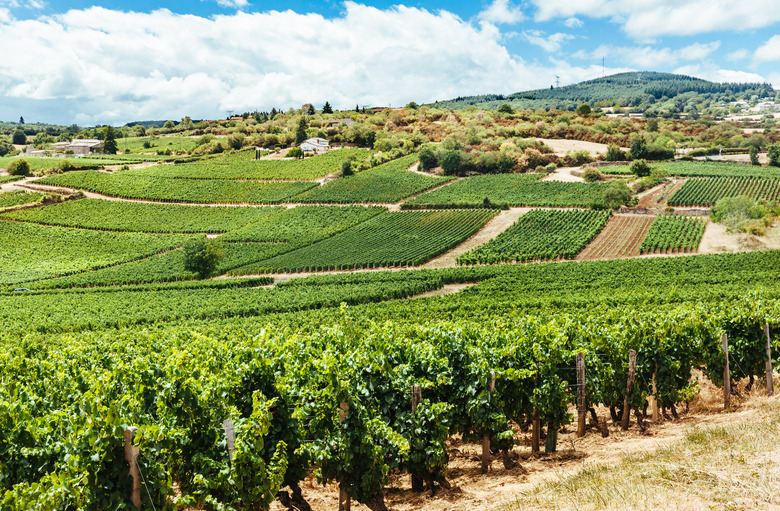Burgundy Still Sets The Standard For Pinot Noir And Chardonnay
Nearly every wine region in France stands as a reference point for other regions growing the same grapes elsewhere. Winemakers the world over who work with cabernet sauvignon, merlot, and the other Bordeaux varieties, for instance, are constantly striving to achieve the level of quality for which Bordeaux itself has long been famous. More than any other corner of the French wine world, though, it is Bourgogne — known to English-speakers as Burgundy — that winemakers strive to emulate. There are a lot of reasons for this, but one of the big ones is the wine world's nearly obsessive love of pinot noir.
What makes Burgundy and its wines great — and, more importantly, distinct — is the region's unique terroir. If you want to learn about the sense of place that term implies, Burgundy is the ideal location to do it. There are five sub-regions in Burgundy, not counting Beaujolais, and about 100 individual appellations (AOCs) — more than in any other French wine region. Those sub-regions contain more than 400 soil types, and this more than anything drives what ends up in your glass. It's not that other parts of the world can't grow great pinot noir — some can. They simply don't have the concentration of vastly different parcels in such close proximity.
The classifications of Burgundy's wines are driven by the vineyard sites themselves. Most everyone wants to speak about, and drink, Grand Cru and Premier Cru wines (from the top-rated appellations), but these account for only a tiny piece of what is grown and bottled in Burgundy — 2 percent and 12 percent, respectively. Village and regional appellations make up the majority of the wines coming from Burgundy, and while they may not inherently rise to the highest level, there are lots of fascinating, delicious, singular wines to consider. These are often ready to drink sooner than their more exalted kin, and are more widely available and affordable to a greater number of people.
If you love pinot noir and chardonnay, it's natural to drink examples from all over the world, to experience the range of styles available. But to truly understand the diverse expressions that can be produced side by side when the land is allowed to speak, you need to drink Burgundy. Small quantities of other grapes are grown in the region (and some, like aligoté, are truly fascinating and delicious), but pinot noir and chardonnay are the king and queen.
I recently spent a week in Burgundy touring vineyard sites, meeting winemakers, and of course trying current and older wines as well as some not yet released. Here are some of the noteworthy selections that crossed my lips.
Domaine Marc Jambon et Fils Cuvée Classique Mâcon-Pierreclos 2016 ($12). Bits of linseed oil mark the nose here. Yellow and green apple flavors are joined by a spice component on the palate. The above-average finish shows flashes of Bartlett pear and wet limestone.
Nicolas Maillet Mâcon-Verzé 2016 ($19). The vines sourced here have more than 45 years of age on them. White flowers and bits of apple are evident on the nose. Sour melon and pear notes define the palate. Oodles of mineral and bits of spice dot the impressively long finish. The lovely mouthfeel and singular focus of this wine are impressive.
Domaine Thibert Pouilly-Fuissé 2016 ($25). This cuvée-style offering was sourced from 25 parcels of vines with an average age of 65 years. Lemon ice notes ring out from the first whiff and carry through the palate. A pure burst of apple is at play and continues through a mineral-laden finish that also shows off some salinity. This is a pure, clean, and fascinating expression of chardonnay.
Albert Bichot Santenay Blanc 2015 ($35). This regional wine from Santenay, in the southern part of Côte de Beaune, is a new offering for Bichot. Roasted Golden Delicious apple aromas jump from the nose. Apricot, orange peel, apple, and a hint of mesquite are evident on the palate. Roasted pineapple notes emerge on the finish along with a touch of limestone.
Louis Latour Château de Blagny Meursault Premier Cru 2015 ($61). Toasted nuts and white flower aromas protrude from the welcoming nose. Yellow fruit, tangerine zest, and dried pear are notable on the layered palate. The prodigiously long finish is remarkably mineral-laden.
Domaine Thevenot Le Brun et Fils Hautes Côtes de Nuits "Les Renardes" 2015 ($15). The light red hue of this wine is what I envision when excellent pinot noir comes to mind. Wild strawberry, white pepper, and hints of Bing cherry are evident from the first whiff to the last sip. A touch of bay leaf shows up on the palate alongside plenty of red fruit. Hints of earth emerge on the solid finish. Racy acid keeps everything in check. This is a remarkable value.
Maison Chanzy Bourgogne 2016 ($18). Bits of funk and bramble are evident on the nose alongside aromas of ripe cherry. Earth, cinnamon, and red fruit flavors dominate the palate. Wisps of chicory, mushroom, and spice show up on the above-average finish. This is a solid entry-level pinot noir for the price.
Château de Chamirey "Clos des Ruelles" Monopole Mercurey 2013 ($44). The welcoming nose is dotted with graphite, bits of forest floor, and black fruit aromas. Black cherry, spices, and traces of savory herbs such as thyme fill the elegant palate. Sour red fruits, like pomegranate, are evident on the long finish, as is finely ground red earth.
Domaine Michel Mallard 2014 Chorey-les-Beaune ($46). Red cherry and savory herb aromas lead the way in this wine, sourced from vines with an average age of 55. The fresh, layered palate shows off red and black cherry, blackberry, and complementary spices. Chicory, black pepper, and more red fruits are evident on the impressive finish. Racy acid keeps things incredibly fresh and compelling.
